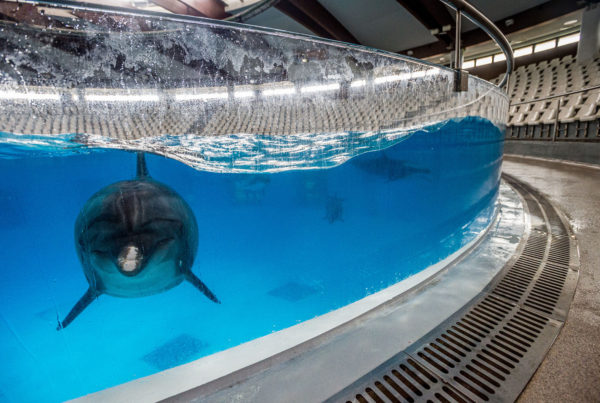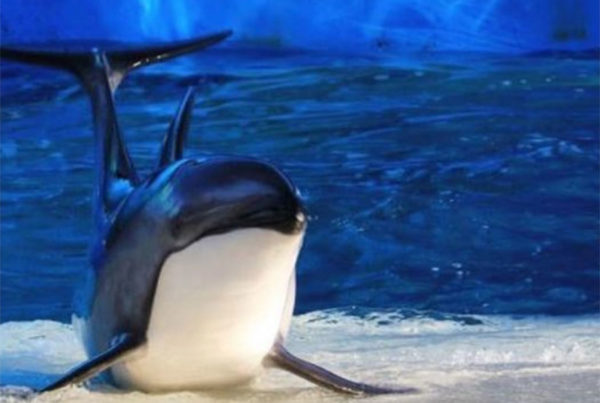Until Lolita is Home is a grassroots movement that advocates for the retirement of Lolita the orca from the Miami Seaquarium.
By raising awareness about Lolita (and ALL cetaceans in captivity) we hope one day she will see her home waters again. We are an all-volunteer group with “members” located around the world.
Lolita (first called Tokitae) was captured on August 8, 1970 in Penn Cove, Whidbey Island. She was one of seven young whales sold to marine parks around the world from this roundup of over 80 orcas conducted by Ted Griffin and Don Goldsberry, partners in a capture operation known as Namu, Inc.
Using speedboats and releasing explosives in the water, they forced the orcas into Penn Cove. Babies were separated from their mothers. The orca mothers would not leave their children, piercing, screaming vocalizations were heard incessantly both above and below water.
Five whales, including four baby whales, drowned during this capture. The four drowned calves had their bellies slit, were filled with rocks, and weighted with chains and anchors to keep their deaths from coming to the attention of the public.
In mid-November a trawler dragged the bodies of the drowned infants into its net. The captain of the fishing boat deposited the dead baby whales on a beach in front of a Seattle newspaper reporter, and the story was immediately told to the world. Six years later this discovery played a major role in a court decision that banned Sea World from ever capturing another killer whale in Washington State.
Calls were made to aquariums around the world to announce that killer whales were for sale. Dr Jesse White, the veterinarian for the Miami Seaquarium, came to Washington to select one. He admired a particular little female and soon chose her.
Dr White had visited a curio shop while in Seattle and saw the name Tokitae on a carving, a name he bestowed on the little whale who seemed “so courageous, and yet so gentle.” In Miami, she became a show business personality, and the owners didn’t want people to know where she came from, so she needed a name that said Miami, not Seattle. Her stage name became Lolita.
On September 24, 1970, Lolita arrived at the Seaquarium. She joined another Southern Resident Orca named Hugo who was captured at around 4-6 years of age, in February 1968 in Vaughn Bay, nr. Puget Sound, Washington.
A small circular tank was constructed for Lolita, called “The Whale Bowl.” Hugo and Lolita’s tanks were several hundred feet apart, but they would call out to one another. Trainers decided the orcas would be compatible and put them together. At first, they were aggressive towards each other and Hugo became aggressive towards his handlers.
A back part of The Whale Bowl was added on, along with heavy gates. The orcas performed 5-6 shows per day for the ten years they were together. They shared their small pool with a variety of other cetaceans, including pacific white-sided dolphins.
Hugo and Lolita eventually mated, much to the delight of Seaquarium employees. According to the St. Petersburg Times, “although Lolita was pregnant a few times, she never delivered a live offspring.” It is believed she gave birth May 16, 1973 to a stillborn calf but other dates are unknown.
Over the next ten years Hugo banged his head against the walls of his tank on many occasions, once slicing the tip of his rostrum off when he broke the thick glass of the viewing window. Veterinarian Jesse White sewed Hugo’s severed rostrum back on.
Then in March of 1980, just about the time Hugo’s adolescent hormones began to kick in at the age of about 15, he rammed the wall of the tank and died. The official report said he died of a brain aneurysm. Lolita, “so courageous yet so gentle,” continued to perform her shows.
Hugo had spent 12 years in captivity at the Seaquarium. His body was unceremoniously placed in the Miami Dade Dump.
Killer whales are incredibly intelligent, sentient and social creatures. In the wild Lolita would still be living with her mother, they swim hundreds of miles a day, diving as deep as 500 feet. Alone in her tank, she swims in circles inside the 35 foot wide area and can only dive as deep as 20 feet, in a small area in the center of the tank. When not performing in her show, Lolita floats listlessly, she still vocalizes her pod’s calls.
Orcas are incredibly sensitive to sound. In the wild, they avoid loud noises. They use echolocation to navigate in the water and to locate objects. Living in a concrete box is torture for an animal that uses this type of heightened sense as their sound waves bounce off of their prison walls. At least 40 other captives from her extended family had perished by 1987, and yet she goes on, day after day in a tub she can barely turn around in. Her perseverance is a mystery, but she shows her amazing courage and gentle spirit every day. Undoubtedly she remembers her family who raised her and the world she grew up in before her capture.
THE BEST WAY TO HELP LOLITA (AND ALL CETACEANS):
- Don’t Buy a Ticket to Miami Seaquarium, SeaWorld, swim with the dolphin programs or any attractions that use animals as entertainment. Encourage your friends and family to do the same.
- Watch Blackfish, The Cove, and share the truth about captivity.
- Attend a Rally! – or sign up to host your own.
- Share Lolita’s story
- Read: Orca Network’s Lolita’s Retirement Plan
- Follow Us: Facebook



